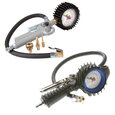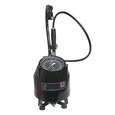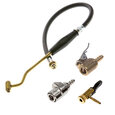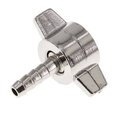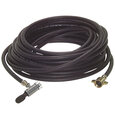Tire Inflator Types, How to Select and How to Use It
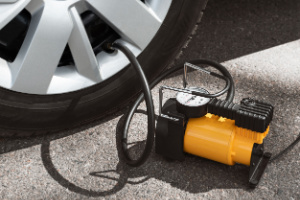
Figure 1: Tire inflator for cars
Tire inflators come in various types, including portable, digital, and cordless inflators. Some inflators are pre-set, automatically stopping when the set pressure is achieved, while others are manual, requiring the user to monitor and stop inflation manually. This article is a comprehensive guide to the main car tire inflators, their selection criteria, and how to inflate car tires.
Table of contents
- What is a tire inflator
- Tire inflator types
- How to select a tire inflator
- How to inflate car tires
- FAQs
View our online selection of tire inflators!
What is a tire inflator
A tire inflator inflates vehicle tires to the correct air pressure. These devices ensure that tires operate at the recommended PSI, promoting optimal vehicle performance, safety, and fuel efficiency. When connected to a tire's valve stem, the inflator uses an electric motor and pump to draw air from the surroundings and force it into the tire until the desired pressure level is reached. Use a tire inflator to check the tire pressure in the following cases:
- Low tire pressure
- Poor fuel efficiency
- Uneven or visible tire wear
- Handling and braking issues
- Frequent tire maintenance
Tire inflator types
Tire inflators are primarily classified on the basis of their operation mechanism and the presence of cords to charge.
Operation mechanism
- Pre-set inflators: The operator sets the desired pressure level, and the inflator stops automatically when the device crosses the set pressure. These inflators have electronic components, ensuring high levels of accuracy. The pre-set feature allows the operator to multitask during inflation, improving efficiency, uptime, and safety. It also reduces the physical effort and fatigue usually associated with inflating large, high-pressure tires from flat.
- Manual inflators: The operator sets the required pressure and stops the operation manually when the set pressure reaches. These inflators are portable and can be used in various locations without relying on the main power.
Corded and cordless
- Corded Inflators: Corded inflators use a 12V power plug that connects to the vehicle's 12V jack, drawing power from the car's battery. These are convenient and eliminate the need to keep an additional battery charged. The inflator can operate smoothly as long as the car's battery has power.
- Flexible corded inflators: While most corded inflators operate solely on 12V power, some versatile models can utilize both 12V and 120V power sources. These inflators can be plugged into standard electrical outlets in addition to 12V jacks, offering increased flexibility and adaptability.
- Cordless inflators: Cordless inflators use rechargeable batteries to power their motor and pump. Certain cordless inflators have built-in batteries that can be charged via USB or 120V power, while others feature removable batteries. They are flexible and don't rely on an additional power source to inflate tires.
Other types
Among the various types discussed above, there are multiple subcategories.
-
Portable tire inflator:
- Portable tire inflators are compact and versatile tire inflators suitable for individual vehicle owners and small businesses.
- They are typically powered by the vehicle's 12V power outlet and can be easily carried in the trunk.
- Some models may have additional features such as built-in pressure gauges, LED lights, and multiple nozzle attachments for inflating other inflatable items like sports equipment or air mattresses.
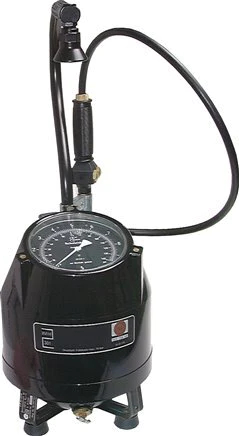
Figure 2: Portable tire inflator with pressure gauge
A pistol grip tire inflator is a portable car inflator that resembles the shape of a pistol or gun grip. The pistol grip design allows for easy handling and comfortable operation, as users can grip the inflator securely with one hand while using the other hand to connect the hose to the tire valve. These inflators typically have a built-in pressure gauge that displays the current tire pressure, allowing users to monitor and adjust the inflation process accurately.
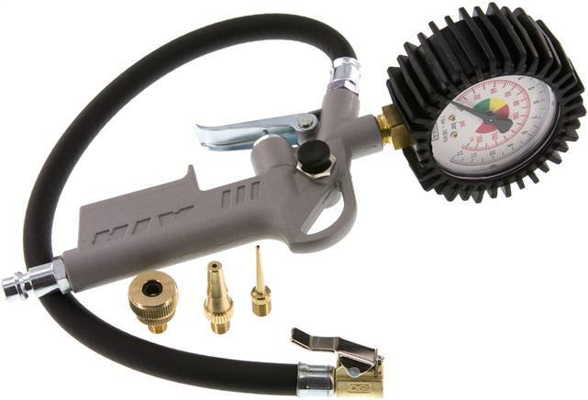
Figure 3: Pistol grip tire inflator
-
Digital tire inflator:
- Digital tire inflators provide precise pressure readings on a digital display and allow users to set the desired PSI (pounds per square inch) before inflation.
- They have LCD screens that display real-time pressure information and automatically shut off once the desired pressure is reached, preventing over-inflation.
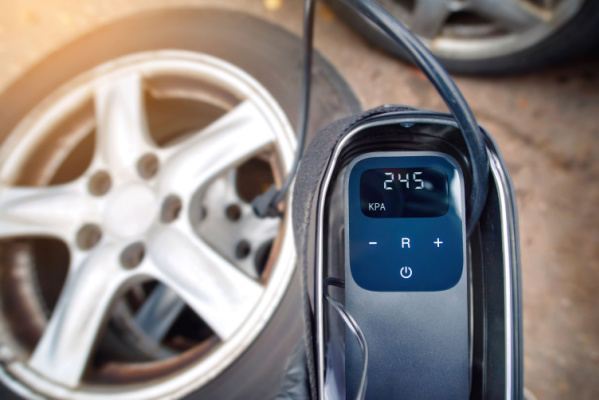
Figure 4: Digital tire inflator
-
Heavy-duty industrial inflator:
- Heavy-duty industrial tire inflators are designed for commercial fleets and large-scale operations.
- They have higher airflow rates and are capable of handling multiple tires continuously.
- Some models may feature extra-long hoses and heavy-duty construction to withstand demanding working conditions.
How to select a tire inflator
- Power source: Choose corded or cordless tire inflators depending on the availability of the power source.
- Pressure: The pressure capability of a tire inflator directly affects inflation speed. Choose a compressor with a minimum of 6.89 bar (100 psi) for faster inflation. Most inflators can easily fill car tires to 2.06 - 2.76 bar (30 - 40 psi).
- Inflation time: The inflation time can vary from 10 to 30 minutes based on output capacity.
- Duty cycle: The duty cycle is the time a compressor can run before it cools down. Most tire inflators have around 15-minute duty cycles due to heat generation during high-speed compression. An inflator with a shorter duty cycle works well when filling sports equipment or pool floats, but it can be a major drawback when filling the tires of large trucks. Therefore, many portable tire inflators clearly mention they’re not designed for truck tires.
- Gauge readability: Ensure easy reading of the pressure gauge for accurate inflation. Digital gauges with backlighting are user-friendly. Analog gauges with large numerals can also work well but might be challenging to read in low-light conditions.
- Automatic shut-off: Automatic shut-off functions protect inflators from overheating. Shutoff can be triggered by pressure, temperature, or time, ensuring safe and efficient operation.
- Hose length: An optimal hose length is 16 to 20 inches (40 to 51 cm), balancing convenience and manageability. Coiled hoses offer stretchability and are useful for off-road enthusiasts and large vehicle owners.
- Weight and portability: Tire inflators are lightweight and portable, weighing less than a pound. Compact models are ideal for road trips, fitting in trunks and even glove boxes.
- Ease of use: Features like programmable pressure regulators and built-in pressure gauges are user-friendly, preventing overfilling and providing real-time pressure display.
How to inflate car tires
Here's a step-by-step guide on how to inflate car tires properly:
- Check tire pressure: Before inflating the car tires, it's essential to know the recommended tire pressure, which can be found in the vehicle's owner's manual, on a sticker inside the driver's door jamb, or on the sidewall of the tire itself. Note the recommended PSI (pounds per square inch) for each tire.
- Choose the right tire inflator: Portable air compressors, digital tire inflators, or cordless tire inflators are all suitable choices to inflate car tires.
- Park the car: Park the car on level ground and engage the parking brake. Ensure there is enough space around the tires.
- Attach the inflator to the valve: Unscrew the valve cap from each tire. If using a tire inflator with a hose, connect the nozzle securely to the valve stem.
-
Inflate the tires:
- Set the desired PSI based on the recommended tire pressure.
- Switch on the inflator or air pump, and the tire will start to inflate.
- Keep an eye on the tire pressure gauge (if available), or use the digital display to monitor the pressure.
- Check the tire sidewall or inside the vehicle's door for the manufacturer's recommended pressure. For cars and trucks, it's usually between 2.06 - 2.75 bar (30 and 40 psi), while bicycles can range from 1.37 - 8.7 bar (20 to 130 psi) depending on tire size and style.
- Check pressure: Check the tire pressure periodically while inflating to avoid over-inflation. If using a manual inflator without a pressure gauge, use a separate tire pressure gauge to measure the pressure and adjust accordingly.
- Inflate to the recommended pressure: Continue inflating the tire until it reaches the recommended pressure for that specific tire. Be careful not to over-inflate, as it can cause tire damage and reduce stability. In the event of accidentally over-inflating a tire, release some air by gently pressing the valve stem pin with a small object until the desired pressure reaches.
- Recheck and replace valve caps: Once the tires are inflated to the correct pressure, screw the valve caps back on securely to protect the valve stem. Repeat the process for all tires.
Note: If the inflator struggles to build pressure, inspect the tire for punctures or excessive wear that may be causing the issue.
FAQs
How often should I check my tire pressure?
Check your tire pressure at least once a month and before long trips to ensure optimal performance and safety.
How long does it take to inflate a tire using a tire inflator?
The inflation time can vary depending on the inflator's output capacity and tire size, typically ranging from 10 to 30 minutes.
What type of tire inflator is best for regular car maintenance?
A portable air compressor is a popular choice for regular car maintenance as it is compact, versatile, and easily powered by the vehicle's 12V power outlet.




